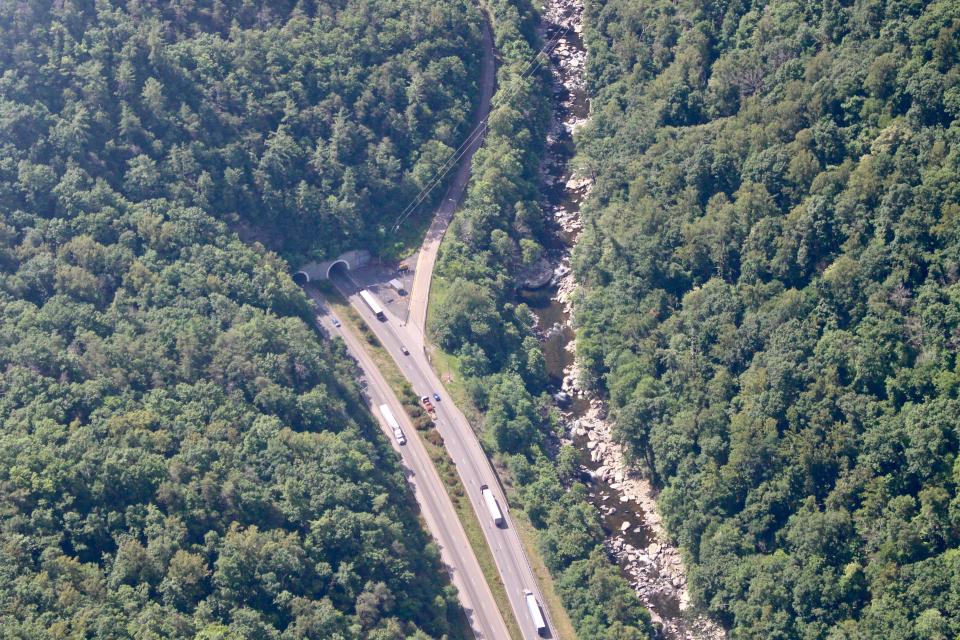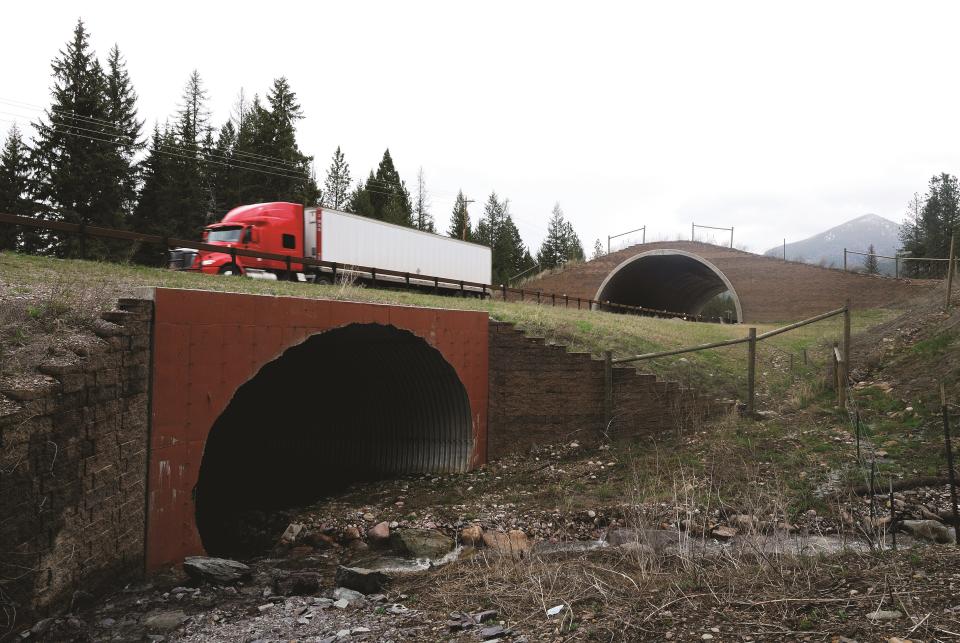Word from the Smokies: Keys to wildlife crossing success on I-40 in the Pigeon River Gorge

On Nov. 3, the North Carolina Department of Transportation announced that when it begins to replace the Harmon Den bridge on Interstate 40 between Asheville and Knoxville later this month, a wildlife underpass will be included in the construction.
Just 48 hours later, the House passed a $1.2 trillion infrastructure bill including $350 million for a wildlife crossings pilot program that will provide grants to states, tribes, local communities, federal agencies and other land managers seeking to improve habitat connectivity by implementing wildlife crossing structures.
What’s going on? Lagging behind Europe, Canada and many others, the United States is realizing its need as well as its ability to change the roads that imperil both the animals and the humans who dare to navigate them.
“Wildlife movement patterns developed over countless millennia as an adaptation to the ever-changing habitats and territory opportunities across the landscape and as an important dynamic to prevent inbreeding,” said Hugh Irwin, senior conservation specialist with the Wilderness Society. “Our highways were constructed across these important wildlife corridors in the blink of an eye in relationship to this long-term time frame. It is critically important now to adapt highway infrastructure to wildlife needs.”

► Word from the Smokies: Book teaches youths about need for wildlife crossings
North Carolina wildlife contends with 80,000 miles of state-maintained highways that crisscross the landscape where many species still navigate using their own long-established system of unpaved pathways. Over the three-year period of 2017-19, there were 56,868 wildlife-vehicle collisions, more than 2,800 human injuries, five human fatalities — and all this cost $156.9 million in property damage according to a June 2020 NCDOT study.
In Western North Carolina, some 1,900 black bears as well as a dispersing herd of nearly 200 elk move in and out of the boundary of Great Smoky Mountains National Park in order to seek mates, food and shelter. To do so, they are often faced with a tough decision: where, when and how to cross several busy roads, including I-40 in the Pigeon River Gorge.
“This highway was built during the 1960s without any thought for wildlife or their movement patterns,” says Tim Gestwicki, CEO of the North Carolina Wildlife Federation. “Solving this problem will require long-term strategizing and resources from departments of transportation, federal and state governments, and society at large.”
Since 2017, two dozen federal, state, tribal, and non-governmental organizations have been collaborating as Safe Passage: The I-40 Pigeon River Gorge Wildlife Crossing Project, working alongside state departments of transportation to make 20 miles in Western North Carolina and eight miles in East Tennessee more permeable for wildlife and safer for drivers. Research now holds the key to their success.

► Word from the Smokies: Park scientists, nature writers reflect on the meaning of ‘habitat’
“During our two-year study, we documented abundant and rich wildlife close to the highway, much more than we expected,” said Steve Goodman, a conservation biologist with National Parks Conservation Association conducting Pigeon River Gorge research funded by the Volgenau Foundation.
Data is now being crunched from 120 wildlife camera traps and GPS collars used to track elk movements, allowing Goodman and research partner Dr. Liz Hillard of Wildlands Network to make recommendations for both North Carolina and Tennessee departments of transportation as they improve several bridges on I-40 over the next five years. The first is Harmon Den, where black bear, white-tailed deer, elk, and many other species live on both sides of I-40 adjacent to the Harmon Den Black Bear Sanctuary.
“We are gaining tremendous insight into where wildlife is attempting to cross and where activity levels are highest, as well as an understanding of the permeability of existing structures not originally designed for wildlife,” Goodman said. “You might even say wildlife is ‘showing us the way.’”
► Word from the Smokies: Wildlife biologist helps elk return to Appalachia
► Word from the Smokies: 21,183 species, and Discover Life in America keeps on discovering
From September 2018 to December 2020, Goodman and Hillard tallied 140 bear, deer, and elk dead along the highway in the study area, with some of the data provided by NCDOT and NCWF. And they expect that is just the tip of the iceberg, as many animals hit on roads die far from the right-of-way and are never discovered.
“Collecting, analyzing, and mapping this information will allow us to help identify wildlife conflict areas along the roadway and thus where focused efforts would likely increase the success of providing safe passage for wildlife and increasing human safety,” Hillard said.
Bear, deer and elk are the focal species of study in the gorge not only because they are easy to track, but because they create the greatest safety hazards for motorists.
“These three species also require large home ranges and can make large movements to account for seasonal changes in food resources, making their interactions with roads more likely,” Hillard said.
The researchers expect that providing safe passage for these large charismatic mammals will also allow them to help many smaller species cross the interstate safely.

► Word from the Smokies: 4 new snakes discovered by UNCA prof, Smokies researcher in 6 years
“In conjunction with our data, we will incorporate landscape features to interpret and predict wildlife patterns and apply ecological principles and engineering feasibility to identify key focal areas,” Goodman said. “In the next few months, we will submit formal recommendations to NCDOT and TDOT for new structures or improvements to existing ones, together with strategically placed fencing to help funnel wildlife.”
Road ecologists, conservation biologists, and wildlife managers prescribe a buffet of wildlife crossing structures coupled with roadside fencing as the best method of increasing road permeability and habitat connectivity as well as decreasing collisions.
Goodman said new structures for the Pigeon River Gorge might include size-appropriate culverts, wildlife underpasses and land bridges. Improvements might include sculpting wildlife benches along steep bridge abutment slopes or replacing obstructive riprap with wildlife-friendly substrates.
“It is only in the last few years that changing attitudes have allowed room for acceptance of designs and expense to facilitate wildlife movement,” said Irwin. “This highlights the importance of the long view — it takes time for the right climate to exist for grand and ambitious plans like Safe Passage to find the right environment to thrive.”

Frances Figart is the Creative Director for the 29,000-member Great Smoky Mountains Association. Find her road ecology book A Search for Safe Passage at SmokiesInformation.org, learn more about or donate to the collaborative project at SmokiesSafePassage.org, and reach the author at frances@gsmassoc.org.
This article originally appeared on Asheville Citizen Times: Wildlife underpass coming to the North Carolina Pigeon River Gorge

